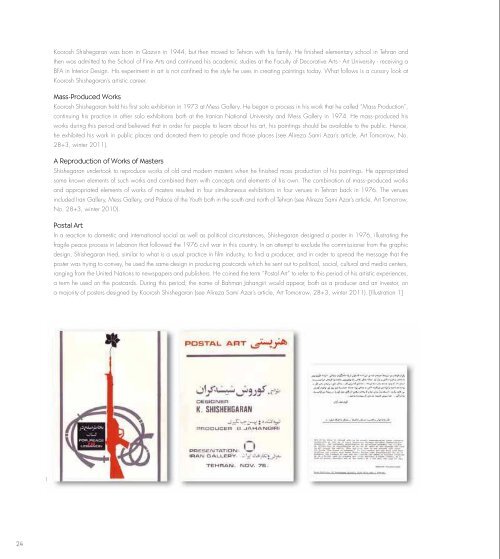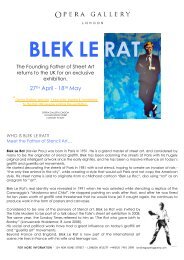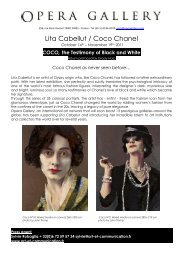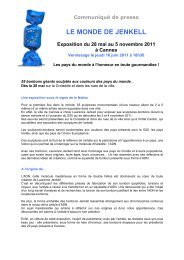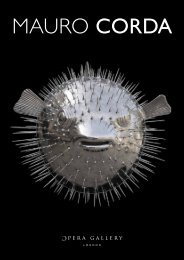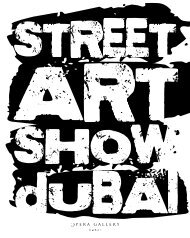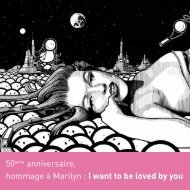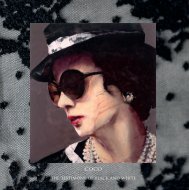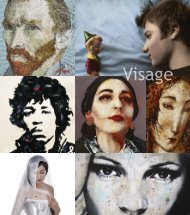Download - Opera Gallery
Download - Opera Gallery
Download - Opera Gallery
You also want an ePaper? Increase the reach of your titles
YUMPU automatically turns print PDFs into web optimized ePapers that Google loves.
Koorosh Shishegaran was born in Qazvin in 1944, but then moved to Tehran with his family. He finished elementary school in Tehran and<br />
then was admitted to the School of Fine Arts and continued his academic studies at the Faculty of Decorative Arts - Art University - receiving a<br />
BFA in Interior Design. His experiment in art is not confined to the style he uses in creating paintings today. What follows is a cursory look at<br />
Koorosh Shishegaran’s artistic career.<br />
Mass-Produced Works<br />
Koorosh Shishegaran held his first solo exhibition in 1973 at Mess <strong>Gallery</strong>. He began a process in his work that he called “Mass Production”,<br />
continuing his practice in other solo exhibitions both at the Iranian National University and Mess <strong>Gallery</strong> in 1974. He mass-produced his<br />
works during this period and believed that in order for people to learn about his art, his paintings should be available to the public. Hence,<br />
he exhibited his work in public places and donated them to people and those places (see Alireza Sami Azar’s article, Art Tomorrow, No.<br />
28+3, winter 2011).<br />
A Reproduction of Works of Masters<br />
Shishegaran undertook to reproduce works of old and modern masters when he finished mass production of his paintings. He appropriated<br />
some known elements of such works and combined them with concepts and elements of his own. The combination of mass-produced works<br />
and appropriated elements of works of masters resulted in four simultaneous exhibitions in four venues in Tehran back in 1976. The venues<br />
included Iran <strong>Gallery</strong>, Mess <strong>Gallery</strong>, and Palace of the Youth both in the south and north of Tehran (see Alireza Sami Azar’s article, Art Tomorrow,<br />
No. 28+3, winter 2010).<br />
Postal Art<br />
In a reaction to domestic and international social as well as political circumstances, Shishegaran designed a poster in 1976, illustrating the<br />
fragile peace process in Lebanon that followed the 1976 civil war in this country. In an attempt to exclude the commissioner from the graphic<br />
design, Shishegaran tried, similar to what is a usual practice in film industry, to find a producer, and in order to spread the message that the<br />
poster was trying to convey, he used the same design in producing postcards which he sent out to political, social, cultural and media centers,<br />
ranging from the United Nations to newspapers and publishers. He coined the term “Postal Art” to refer to this period of his artistic experiences,<br />
a term he used on the postcards. During this period, the name of Bahman Jahangiri would appear, both as a producer and an investor, on<br />
a majority of posters designed by Koorosh Shishegaran (see Alireza Sami Azar’s article, Art Tomorrow, 28+3, winter 2011). [Illustration 1]<br />
Art + Art<br />
The concept that art did not belong only to galleries, museums and wealthy families<br />
led Shishegaran to widely exhibit and donate his mass-produced works in<br />
public places, thus taking a major step toward popularizing art, a trend which<br />
later continued in Postal Art. This time, however, the significance of the public<br />
aspect of art revealed itself in a different form. This everyday life of people even<br />
could be Art itself; These daily sweet and bitter events or visiting a patient or<br />
helping the elderly cross the street. In effect, whatever exists in the nature and<br />
life itself is a living, dynamic art, made up of diverse art forms. Taking this into<br />
consideration, Shishegaran designed a poster in 1976 under which he wrote<br />
“K. Shishegaran’s Works: Shahreza Ave. Itself”. He found Shahreza Street (now<br />
known as Enqelab Street), a collection of whatever can be called “art”. This<br />
was the specific perspective he wished people to have when passing the street<br />
and in fact he invited people to see Shahreza Street from this point of view.<br />
This truly conceptual experiment was repeated during a visit to Washington in<br />
spring 1977 along with a group of avant-garde artists. This time Shishegaran<br />
made six similar posters and declared Wash Art Expo itself as his artwork in<br />
them. A new title was seen on the posters, though. It read “False Art”. He called<br />
this period of his experiments “Art + Art” (see Alireza Sami Azar’s article, Art<br />
Tomorrow, No. 28+3, winter 2011 - Nasrin Tabatabaie, No. 6, October<br />
2007). [Illustration 2]<br />
Art for Production<br />
Shishegaran began a new period in 1977 and half of 1978. During this<br />
period he collaborated with his brothers, Behzad and Ismail, and others in designing<br />
and producing furniture such as chandelier, wardrobe, armchair, table,<br />
chair, etc. The notion of public art revealed itself in a different form this time. Art<br />
greatly contributed to the production of what was available to people in their<br />
everyday life. He called this period “Art for Production”. Shishegaran and his<br />
brothers put their products on display in 1978. The exhibition poster bore the<br />
name of Bahman Jahangiri, as the producer, and other contributors.<br />
2<br />
1<br />
Socio-Political Posters<br />
When socio-political turbulences in Iran grew in 1978, Koorosh Shishegaran<br />
felt a duty to design two posters in September and October of the same year (a<br />
few months prior to the victory of the 1979 revolution) titled “For A Free Press”<br />
and “For Today”, respectively. These posters opened a window of opportunity<br />
to Koorosh and his brothers Behzad and Ismail Shishegaran who continued the<br />
practice until the late 1981. During this period, they responded to the events of<br />
the time by designing posters with individual signatures but in collaboration with<br />
each other. These posters originally appeared in silkscreen, followed by offset<br />
versions in high print runs. They also organized an exhibition of their posters at the<br />
central library of the University of Tehran in March 1980 (see Arash Tanhayi’s<br />
article, Kheradnameh Hamshahri, No. 68, special edition for story, February<br />
2011 - Arash Tanhayi, Tandis Magazine, No. 168 - Saed Meshki, Neshan<br />
Magazine, No. 18, autumn & winter 2008 - Ali Asqar Qarebaqi, Golestaneh<br />
Magazine, No. 9, October 1999). [Illustration 3]<br />
3<br />
24 25


